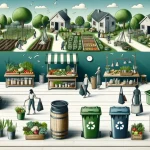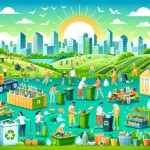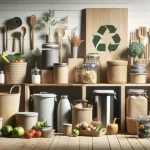
Ready to embark on a sustainable journey? Learn how to go zero-waste with our easy, step-by-step guide. Embrace eco-friendly living and make a positive impact today!
How to Go Zero-Waste Key Takeaways:
- How to Go Zero-Waste involves adopting sustainable practices to minimize waste.
- Start by refusing unnecessary items, reducing consumption, reusing products, recycling correctly, and composting organic waste.
- Embrace eco-friendly alternatives and support sustainable brands to make a positive environmental impact.
Thinking about how to go zero-waste but not sure where to start? You’re in the right place!
Join us as we explore simple, practical steps to reduce waste and live more sustainably.
It’s easier than you think, and we’re here to guide you every step of the way!
How to Go Zero-Waste: A Step-by-Step Guide
Embarking on a zero-waste journey is a powerful way to reduce your environmental impact and live more sustainably.
This guide will walk you through the steps to transition to a zero-waste lifestyle, offering practical tips and advice to help you make meaningful changes.
Step 1: Assess Your Current Waste
Start by examining the waste you currently produce. Identify the main sources of waste in your household, such as plastic packaging, food scraps, or disposable products. This assessment will help you pinpoint areas where you can make the most significant impact.
Introduction to Waste Assessment
Embarking on your zero-waste journey begins with understanding your current waste habits.
It’s time to take a closer look at what’s in your trash can.
Identify Your Waste Sources
- Kitchen Waste: Look for food packaging, single-use plastics, and food scraps.
- Bathroom Waste: Notice disposable toiletries, plastic containers, and product packaging.
- Living Areas: Pay attention to paper waste, electronic waste, and miscellaneous items.
Track Your Waste
Keep a waste diary for a week. Write down everything you throw away. This will give you a clear picture of your waste patterns.
Analyze Your Findings
- Common Items: Identify the most frequent types of waste.
- Volume: Note the volume of waste you produce in a week.
- Recyclables: Check how much of your waste is recyclable but ends up in the trash.
Set Waste Reduction Goals
Based on your assessment, set realistic goals for reducing your waste. Aim to tackle the most significant sources of waste first.
Step 2: Refuse and Reduce
The first step in reducing waste is to refuse items you don’t need and reduce what you do use.
Say no to single-use plastics, unnecessary packaging, and items that are not essential.
Focus on simplifying your life and being mindful of your consumption.
Embracing a Mindful Approach
Refusing and reducing are about making conscious choices. It’s time to rethink our needs and wants.
Refuse Unnecessary Items
- Single-Use Plastics: Say no to plastic straws, cutlery, and bags.
- Junk Mail: Opt out of unwanted mail and switch to digital subscriptions.
- Freebies: Resist the temptation of free promotional items that you don’t need.
Reduce Your Consumption
- Packaging: Choose products with minimal or no packaging.
- Quality Over Quantity: Invest in durable items that last longer.
- Energy and Water: Be mindful of your utility usage and look for ways to cut back and conserve water.
Simplify Your Lifestyle

- Declutter: Let go of items you don’t use or need.
- Mindful Shopping: Think twice before making a purchase. Do you really need it?
- DIY Solutions: Make your own cleaning products or toiletries to reduce packaging waste.
Benefits of Refusing and Reducing
- Environmental Impact: Less waste means a smaller carbon footprint.
- Cost Savings: Buying less and choosing reusable options can save money in the long run.
- Mental Clarity: A simplified lifestyle can lead to less stress and more happiness.
Refusing and reducing are powerful steps toward a zero-waste lifestyle.
By being more intentional with our choices, we can significantly decrease the amount of waste we produce.
Step 3: Reuse and Repurpose
Invest in reusable alternatives to disposable items, such as cloth bags, water bottles, and coffee cups.
Look for ways to repurpose items instead of throwing them away. For example, old jars can be used for storage, and worn-out clothing can be turned into cleaning rags.
Embracing a Circular Mindset
Reusing and repurposing are about giving items a second life. It’s time to get creative and find new uses for old things.
Invest in Reusables
- Bags: Switch to cloth or canvas bags for shopping.
- Water Bottles: Choose a durable, reusable water bottle.
- Coffee Cups: Bring your own reusable cup to coffee shops.
Repurpose Household Items
- Glass Jars: Use them for storing bulk foods, leftovers, or as planters.
- Clothing: Turn old t-shirts into cleaning rags or shopping bags.
- Furniture: Refinish or repurpose old furniture instead of discarding it.
Creative Reuse Ideas
- Containers: Reuse food containers for storage or craft projects.
- Packaging: Use shipping boxes for storage or as gift boxes.
- Decor: Repurpose items like wine corks or bottle caps into decorative art.
Benefits of Reusing and Repurposing
- Waste Reduction: Extending the life of items reduces the need for new products.
- Cost Savings: Reusing items can save money on replacements and disposables.
- Creativity: Repurposing encourages creativity and resourcefulness.
Reusing and repurposing are key steps in a zero-waste lifestyle. By finding new uses for old items, we can reduce our environmental impact and foster a more sustainable way of living.
Step 4: Recycle Properly
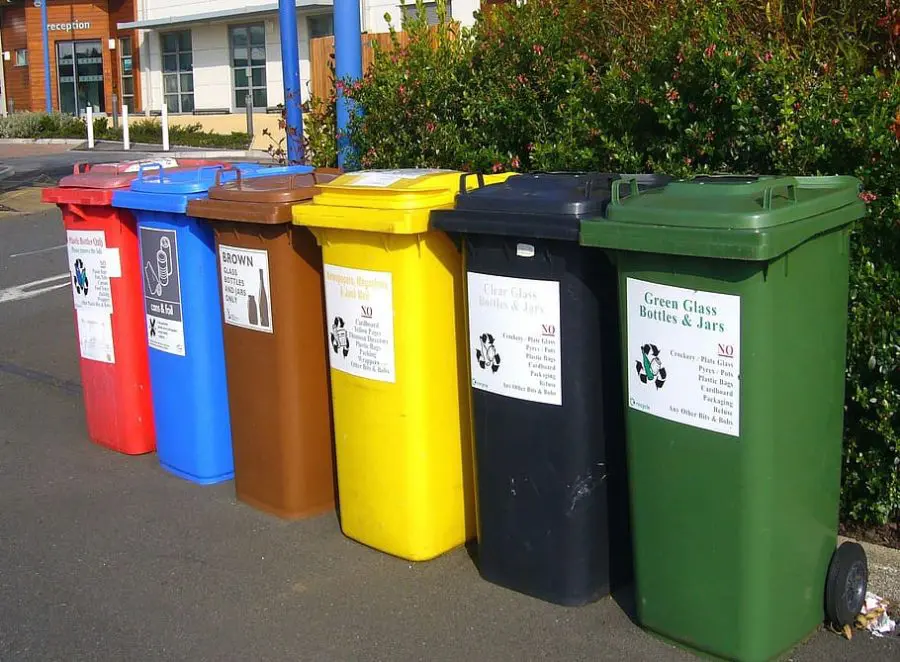
Learn about your local recycling guidelines and make sure you’re recycling correctly.
Not all plastics are recyclable, and improper recycling can contaminate other recyclable materials.
Educate yourself on what can and cannot be recycled in your area.
Navigating the Recycling World
Recycling is a crucial component of waste management, but it’s essential to do it right. Understanding local guidelines is key.
Understand Local Recycling Rules
- Check Guidelines: Each municipality has its own recycling rules. Familiarize yourself with what’s accepted in your area.
- Sort Correctly: Separate recyclables according to local regulations. This often includes paper, glass, metal, and certain plastics.
Identify Recyclable Materials
- Plastics: Look for the recycling symbol and number on plastic items. Not all types are recyclable.
- Paper: Most paper products are recyclable, but check for contamination like food residue.
- Glass and Metal: These materials are generally recyclable, but some exceptions may apply.
Avoid Contamination
- Clean Items: Rinse containers to remove food residue before recycling.
- No Bagging: Don’t put recyclables in plastic bags, as this can clog machinery.
- Proper Disposal: Dispose of non-recyclable items in the trash to prevent contamination.
Recycling Beyond the Bin
- E-Waste: Find local drop-off centers for electronics recycling.
- Hazardous Waste: Dispose of items like batteries and paint at designated facilities.
- Textiles: Donate or recycle old clothing and textiles through special programs.
Benefits of Proper Recycling
- Resource Conservation: Recycling saves raw materials and energy.
- Landfill Reduction: Proper recycling diverts waste from landfills.
- Environmental Protection: Recycling reduces pollution and greenhouse gas emissions.
Recycling properly is a vital step in the zero-waste journey.
By following local guidelines and being mindful of what we recycle, we can ensure that our efforts contribute positively to the environment.
Step 5: Compost Organic Waste
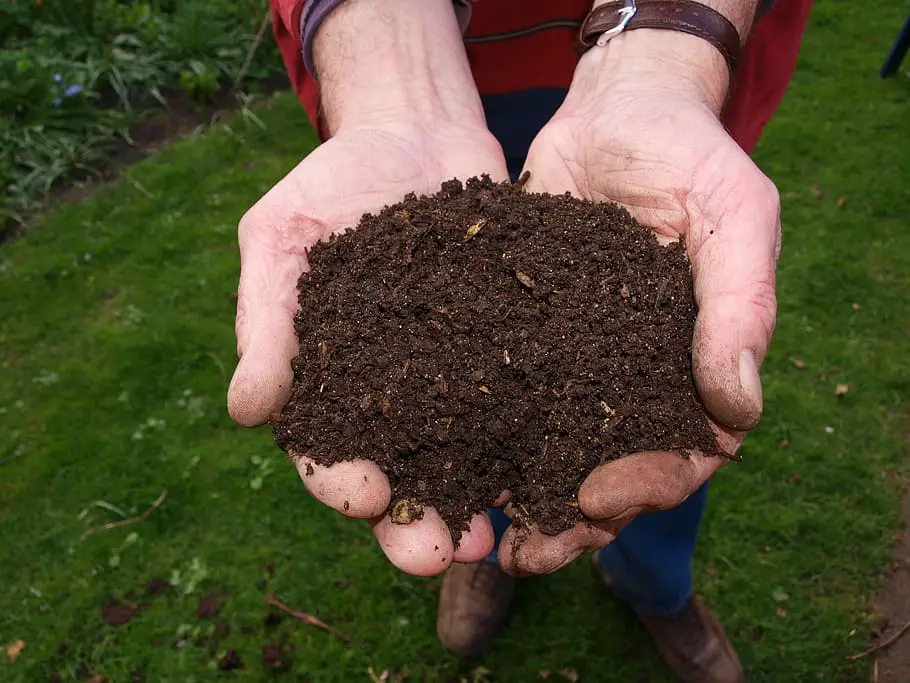
Composting is a great way to reduce food waste and create nutrient-rich soil for your garden.
Set up a compost bin in your backyard or find a local composting facility that accepts food scraps.
Turning Scraps into Gold
Composting transforms organic waste into valuable soil amendments. It’s a natural process that enriches the earth and reduces landfill waste.
Setting Up a Home Compost System
- Choose a Bin: Select a compost bin that fits your space and needs. Options include tumblers, open bins, and worm composters.
- Location: Place your bin in a convenient, well-drained area with good airflow.
- Balancing Greens and Browns: Combine nitrogen-rich “green” materials (food scraps, coffee grounds) with carbon-rich “brown” materials (dry leaves, shredded paper) in a roughly 3:1 ratio.
What to Compost
- Fruit and Vegetable Scraps: All parts of fruits and vegetables can be composted.
- Eggshells: Crushed eggshells add calcium to your compost.
- Coffee Grounds and Filters: Coffee grounds are a nitrogen-rich addition to compost.
What to Avoid
- Meat and Dairy Products: These can attract pests and create odors.
- Oily or Greasy Foods: These can disrupt the composting process.
- Diseased Plants: Avoid composting plant material that may spread disease.
Maintaining Your Compost
- Aeration: Turn your compost regularly to introduce oxygen and speed up decomposition.
- Moisture: Keep your compost pile as damp as a wrung-out sponge.
- Monitoring: Check for signs of decomposition and adjust your green/brown ratio as needed.
Using Your Compost
- Garden Soil: Mix compost into garden beds to improve soil structure and fertility.
- Potting Mix: Use compost as a component in homemade potting mixes for container gardening.
- Mulch: Spread compost around plants to suppress weeds and retain soil moisture.
Benefits of Composting
- Waste Reduction: Composting diverts organic waste from landfills, reducing methane emissions.
- Soil Health: Compost adds essential nutrients and beneficial microorganisms to the soil.
- Sustainability: Composting closes the loop in the food cycle, returning nutrients to the earth.
Composting is a simple and effective way to contribute to a zero-waste lifestyle.
By turning organic waste into a valuable resource, we support a healthier environment and a more sustainable future.
Step 6: Support Sustainable Brands
Support companies that prioritize sustainability and zero-waste practices.
Look for brands that use minimal packaging, offer refillable options, and are transparent about their environmental impact.
Voting with Your Wallet
Choosing to support sustainable brands is a powerful way to promote environmental responsibility.
It sends a message that consumers value sustainability and ethical practices.
Identifying Sustainable Brands
- Transparency: Look for brands that openly share their manufacturing processes, sourcing practices, and environmental policies.
- Certifications: Seek out certifications like B Corp, Fair Trade, or organic, which indicate a commitment to sustainability.
- Packaging: Choose products with minimal, recyclable, or compostable packaging.
Supporting Zero-Waste Initiatives
- Refillable Options: Patronize brands that offer refill stations or returnable containers for their products.
- Waste Reduction: Support companies that actively work to reduce waste in their production and distribution processes.
- Circular Economy: Look for brands that embrace circular economy principles, designing products for longevity and recyclability.
Making Conscious Choices
- Research: Take the time to research brands and their sustainability efforts before making a purchase.
- Local Businesses: Support local and small businesses that prioritize eco-friendly practices.
- Community Impact: Consider the social and environmental impact of the brands you support. Choose those that contribute positively to their communities and the planet.
Benefits of Supporting Sustainable Brands
- Environmental Impact: By choosing sustainable brands, you help reduce pollution, conserve resources, and promote biodiversity.
- Economic Influence: Consumer demand for sustainable products encourages more companies to adopt eco-friendly practices.
- Personal Satisfaction: Knowing that your purchases support ethical and sustainable practices can bring a sense of fulfillment and purpose.
Table: Popular Sustainable Brands
Here’s a table of some popular sustainable brands, along with their focus areas and key sustainability practices:
| Brand | Focus Area | Key Sustainability Practices |
|---|---|---|
| Derma E | Skincare | Plastic- and carbon-neutral, recyclable packaging, cruelty-free and vegan. |
| Made Trade | Home Goods | Climate neutral, fair trade, uses upcycled, recycled, or sustainable materials. |
| Naot | Footwear | Handcrafted, sustainable methods, vegetable-tanned leather, cork footbed, recycled packaging. |
| JanSport | Backpacks | Products made with 100% recycled main body fabric, 100% recycled FSC-certified paper packaging. |
| Puma SE | Sportswear | Sustainable sourcing, aims for 100% sustainable materials by 2025. |
| Unilever | FMCG | Net-zero emissions by 2039, sustainable sourcing, water preservation, wildlife protection. |
| Adidas | Sportswear | Reduced carbon emissions and water consumption, environmental standards, ISO certification. |
| Kering | Luxury Fashion | Sustainable sourcing, Fashion Pact initiator for climate goals. |
| Colorful Standard | Clothing | Locally made, recycled packaging, 100% organic cotton, environmentally-friendly dye. |
| Wearwell | Fashion Marketplace | Partners with brands for positive impact, supports BIPOC-owned brands. |
| KENT | Intimates | Plastic & microplastic-free, 100% biodegradable, certified organic materials. |
| Timberland | Footwear & Apparel | Uses profits and sustainable materials to support the environment, refurbishes used products. |
| Able | Clothing, Bags, Shoes | Fights poverty by creating jobs for women, uses natural materials, fair wages. |
| Reformation | Clothing | Carbon neutral, recycles 75% of waste, invests in charitable programs. |
| Girlfriend Collective | Activewear | Made from recycled materials, eco-friendly dyes, highest ethical certification. |
| Prana | Outdoor & Activewear | Made from organic cotton and recycled wool, Bluesign technology, fair trade certified. |
| Eileen Fisher | Fashion | Holistic approach, organic materials, less water and harmful chemicals. |
| ADAY | Workwear | Eco-friendly fabrics, solar-powered factories, recycled water. |
| Outerknown | Beachwear | Made from recycled fishing nets and nylon surplus, beach lifestyle fashion. |
| Athleta | Activewear | Reduces waste, saves water, Certified B-Corp. |
| Able | Clothing | Aims to end poverty, run by women, empowers them to create sustainable clothing. |
| Tradlands | Clothing | Tailored essentials with a modern twist, natural fibers like cotton, silk, and TENCEL. |
These brands are recognized for their commitment to sustainability, offering a range of products from clothing and footwear to skincare and home goods.
By supporting these brands, consumers can contribute to a more sustainable future.
Supporting sustainable brands is a crucial step in the zero-waste journey.
It not only helps reduce your environmental footprint but also contributes to a larger movement towards a more sustainable and ethical economy.
Step 7: Get Involved in Your Community

Join zero-waste groups, participate in local clean-up events, and advocate for waste reduction policies in your community.
Sharing your journey and encouraging others to adopt zero-waste practices can amplify your impact.
Building a Zero-Waste Community
Taking your zero-waste journey beyond your home and into your community can create a larger impact. Here’s how you can get involved:
Join Zero-Waste Groups
- Local Groups: Look for zero-waste or sustainability groups in your area. These groups often organize events, share resources, and provide support.
- Online Communities: Join online forums or social media groups dedicated to zero-waste living. This can be a great way to connect with like-minded individuals and exchange ideas.
Participate in Local Clean-Up Events
- Beach or Park Clean-Ups: Volunteer for organized clean-up events in your community. This is a direct way to reduce waste in your local environment.
- Start Your Own Event: If there aren’t existing clean-up events in your area, consider organizing one. You can collaborate with local organizations or use social media to gather volunteers.
Advocate for Waste Reduction Policies
- Contact Local Representatives: Reach out to your city or town representatives to advocate for waste reduction policies, such as banning single-use plastics or improving recycling programs.
- Support Sustainable Initiatives: Show your support for local businesses and initiatives that prioritize sustainability. This can include farmers’ markets, zero-waste stores, or community gardens.
Educate and Inspire Others
- Share Your Journey: Use your experiences to educate others about the benefits of zero-waste living. This can be through social media, blogging, or simply talking to friends and family.
- Host Workshops or Presentations: Offer to share your knowledge at local schools, libraries, or community centers. You can teach others how to start their own zero-waste journey.
Benefits of Community Involvement
- Amplified Impact: Working together as a community can lead to more significant changes and a greater reduction in waste.
- Increased Awareness: By spreading the word and leading by example, you can inspire others to consider their environmental impact and make more sustainable choices.
Getting involved in your community is a rewarding way to contribute to the zero-waste movement.
By taking collective action, we can work towards a cleaner, healthier planet for everyone.
Read more about zero-waste principles and practices
Read more about Designing a Zero-Waste Lifestyle
Zero-Waste Living FAQs
Embarking on a zero-waste lifestyle can be a rewarding journey toward sustainability.
However, it often comes with questions and uncertainties. To help you navigate this path, we’ve compiled a list of frequently asked questions about zero-waste living.
Whether you’re just starting out or looking to deepen your commitment, these answers can provide guidance and clarity.
Q: What is zero-waste living?
A: Zero-waste living is a lifestyle that aims to reduce the amount of waste sent to landfills, incinerators, or the environment.
It involves rethinking our consumption patterns, choosing reusable and sustainable products, and minimizing our overall environmental impact.
Q: How do I start a zero-waste lifestyle?
A: Start by assessing your current waste habits and identifying areas for improvement.
Gradually replace disposable items with reusable alternatives, shop in bulk to reduce packaging waste, and compost organic waste.
Educate yourself on local recycling guidelines and strive to make more sustainable choices in your daily life.
Q: Is zero-waste living expensive?
A: While some sustainable products may have a higher upfront cost, zero-waste living can ultimately save money in the long run.
By reducing consumption, reusing items, and shopping in bulk, you can lower your overall expenses.
Additionally, many zero-waste swaps, like using cloth bags or making your own cleaning products, are cost-effective.
Q: Can I really make a difference with zero-waste living?
A: Absolutely! Every small action contributes to a larger impact.
By adopting zero-waste practices, you’re not only reducing your personal waste but also setting an example for others and driving demand for more sustainable products and policies.
Q: How do I handle situations where zero-waste options aren’t available?
A: Zero-waste living is about progress, not perfection. When faced with limited options, do your best to make the most sustainable choice available.
Over time, as you become more experienced and resourceful, you’ll find creative ways to navigate these challenges.
Q: What do I do with items that can’t be reused or recycled?
A: For items that can’t be reused or recycled, consider responsible disposal options.
Some materials, like certain electronics or hazardous waste, may have special disposal facilities.
For other items, think about ways to repurpose or upcycle them before resorting to throwing them away.
By addressing these common questions, we hope to provide a clearer understanding of zero-waste living and encourage more individuals to embrace this sustainable lifestyle.
Remember, every step toward zero waste is a step in the right direction for our planet.
Go Zero-Waste: Step-by-Step Conclusion
Embracing a zero-waste lifestyle is a journey of mindful living and sustainable choices.
It’s about reevaluating our habits, making conscious decisions, and finding creative solutions to reduce our environmental impact.
By following the steps outlined in this guide, you can embark on a path that not only minimizes waste but also promotes a healthier, more sustainable world.
The Ripple Effect of Zero-Waste Living
- Personal Impact: Each small change you make contributes to a significant reduction in waste and a lighter ecological footprint.
- Community Influence: Sharing your zero-waste journey with others can inspire and motivate them to adopt similar practices, amplifying the overall impact.
- Global Benefits: Collective efforts in zero-waste living can lead to a cleaner environment, reduced pollution, and a more sustainable future for our planet.
Continuing the Journey
- Stay Informed: Keep learning about sustainability and zero-waste practices. The journey doesn’t end here; it evolves as new information and innovations emerge.
- Be Adaptable: Zero-waste living is not a one-size-fits-all approach. Adapt the principles to fit your lifestyle and circumstances, and be open to change as you grow in your journey.
- Celebrate Progress: Recognize and celebrate your achievements, no matter how small. Every step forward is a victory for you and the environment.
Final Thoughts
In conclusion, transitioning to a zero-waste lifestyle is a meaningful and rewarding endeavor.
It’s a commitment to living more harmoniously with our planet and fostering a sustainable future for all.
By following these steps and embracing the zero-waste mindset, you can make a positive difference in the world, one choice at a time.
Learn more: Mastering Zero-Waste Living: 7 Easy Tips and Tricks
Resources for Further Reading on Zero-Waste Living
Delving deeper into the world of zero-waste living can provide valuable insights and practical tips for your journey.
Here are some authoritative articles that offer a wealth of information on the subject:
- “What is zero waste?” – World Economic Forum
- A comprehensive guide to the principles of zero-waste living, emphasizing the 5 Rs: refuse, reduce, reuse, recycle, and rot.
- Read more
- “How to Reduce Waste: 21 Ideas for Zero Waste Living” – One Tree Planted
- Offers a collection of 21 easy zero-waste tips to help reduce your waste in a way that fits your lifestyle.
- Read more
- “Going Plastic Free: What Does a Zero Waste Future Look Like?” – Greenpeace USA
- Explores the concept of a zero-waste future, highlighting hyperlocal production and sustainable practices in communities.
- Read more
- “How Communities Have Defined Zero Waste” – US EPA
- Discusses various definitions of zero waste as adopted by different communities, emphasizing a whole-system approach to resource and waste management.
- Read more
These resources cover a range of topics from the basics of zero-waste living to more specific areas like sustainable shopping, community involvement, and policy advocacy.
Whether you’re a beginner or looking to expand your knowledge, these articles provide valuable insights into creating a more sustainable and waste-free lifestyle.



